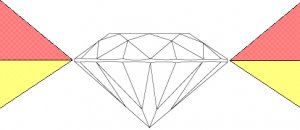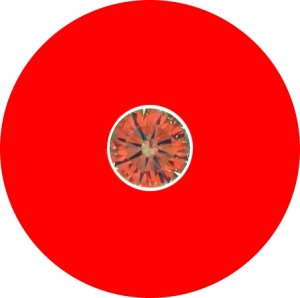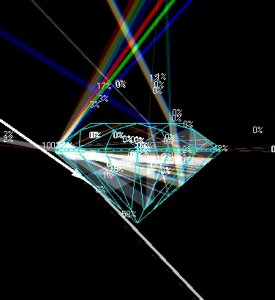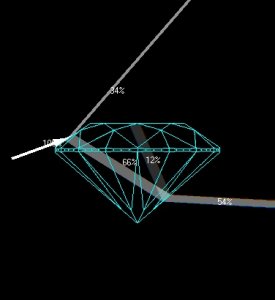Superidealist
Brilliant_Rock
- Joined
- Sep 10, 2003
- Messages
- 655
Interpretation of Firescope-like images assumes the following two principles:
i) White light enters through the diamond’s pavilion.
ii) Red light enters through the diamond’s crown.
To drastically oversimplify, white is bad because it represents light leakage through the pavilion and red is good because it represents light returned through the crown.
The interior of a Firescope-like device is red above the girdle plane and white or black below. (For the sake of simplicity, let us assume the lower interior to be white.) Herein lies a problem. The geometry of the diamond and the design of the device cause the violation of items i and ii, above.
The first graphic represents a diamond within a Firescope-like device. The upper interior surfaces of the device lying in the red shaded region allow red light to enter through the diamond’s pavilion, while the lower interior surfaces of the device lying in the yellow shaded region allow white light to enter through the diamond’s crown. Red light entering through the pavilion in manner such that it is visible to the viewer would be interpreted as light return when it truly represents light leakage. White light entering through the crown in manner such that it is visible to the viewer would be interpreted as light leakage when it truly represents light return.
The second graphic illustrates a proposal to reduce this effect. Imagine a sticker in the shape of an annulus, red above and white below, surrounding the diamond in the device’s tray. The sticker would block much (but not all) of the light from the problem regions while returning red light to the crown and white light to the pavilion.

i) White light enters through the diamond’s pavilion.
ii) Red light enters through the diamond’s crown.
To drastically oversimplify, white is bad because it represents light leakage through the pavilion and red is good because it represents light returned through the crown.
The interior of a Firescope-like device is red above the girdle plane and white or black below. (For the sake of simplicity, let us assume the lower interior to be white.) Herein lies a problem. The geometry of the diamond and the design of the device cause the violation of items i and ii, above.
The first graphic represents a diamond within a Firescope-like device. The upper interior surfaces of the device lying in the red shaded region allow red light to enter through the diamond’s pavilion, while the lower interior surfaces of the device lying in the yellow shaded region allow white light to enter through the diamond’s crown. Red light entering through the pavilion in manner such that it is visible to the viewer would be interpreted as light return when it truly represents light leakage. White light entering through the crown in manner such that it is visible to the viewer would be interpreted as light leakage when it truly represents light return.
The second graphic illustrates a proposal to reduce this effect. Imagine a sticker in the shape of an annulus, red above and white below, surrounding the diamond in the device’s tray. The sticker would block much (but not all) of the light from the problem regions while returning red light to the crown and white light to the pavilion.









300x240.png)